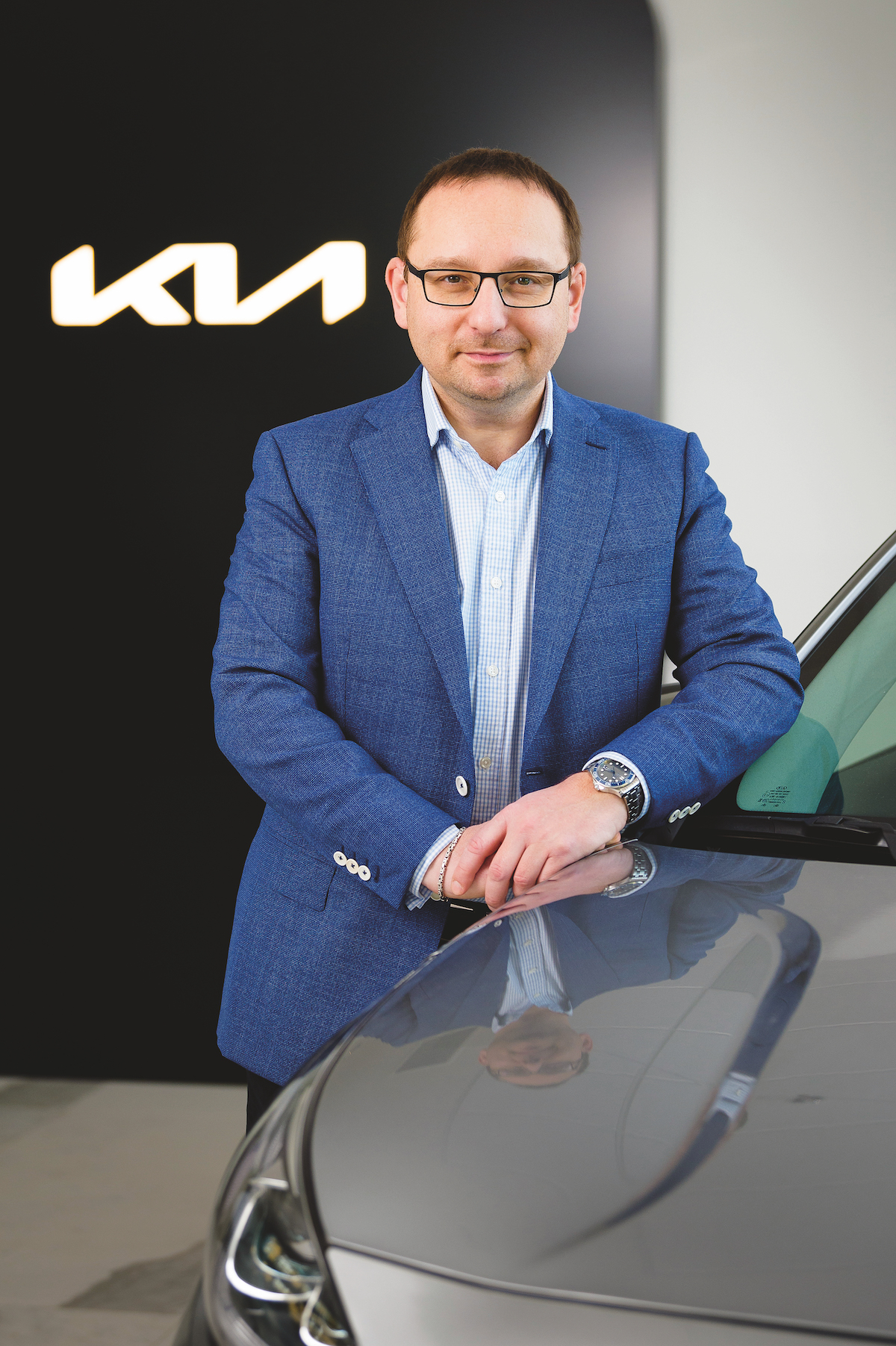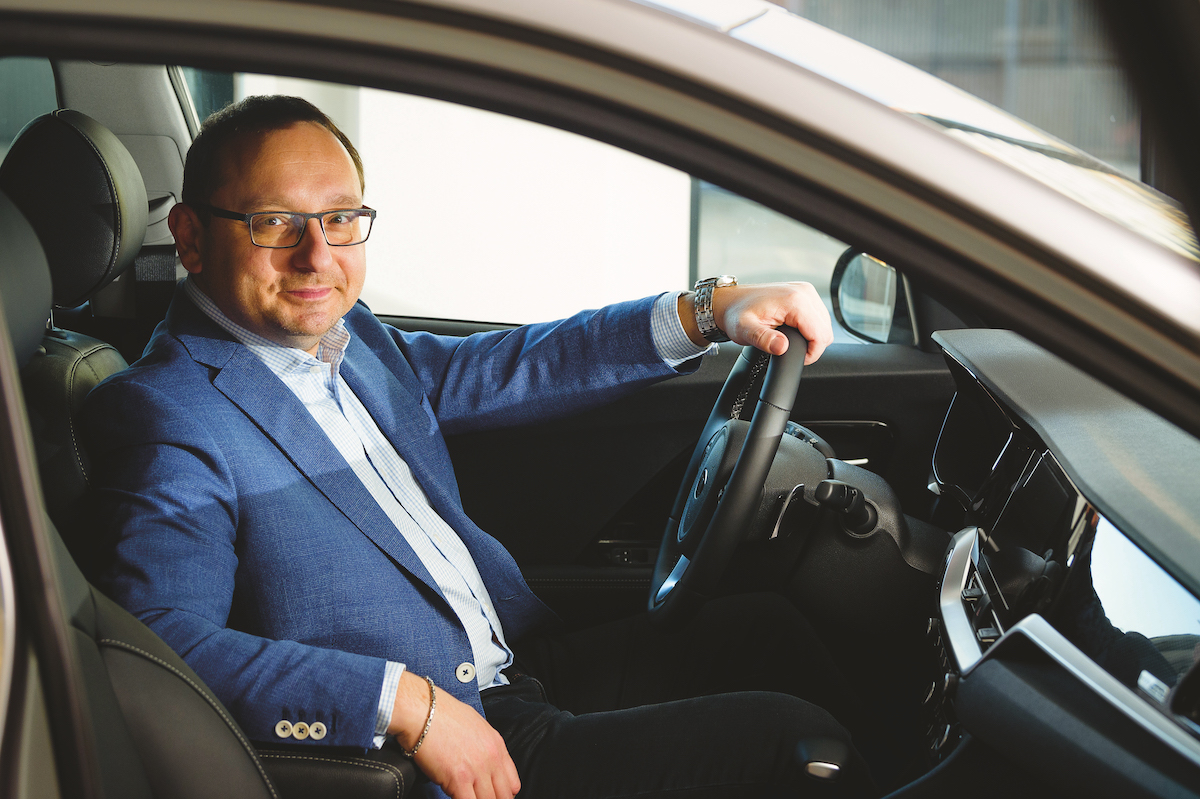“The future will be MANIFOLD”

Arnošt Barna, Managing Director of KIA Czech
Text: Martina Hošková and M. Zisso; Photo: Archive
Arnošt Barna, Managing Director of Kia Czech since 2018, has recently sat down with us to talk about his 30 years of experience in the car industry. “I have loved cars and technology since I was a little boy, so it was not a difficult decision back then to study this field at university and start working for different brands immediately after graduation. I have connected with cars all my life,” he explains where his passion lies. Let us take a glimpse at his world, the world of a distinguished, highly experienced professional in his own field.
Can you tell us a bit about your early days in the industry, and what it is that fascinates you so much about cars?
I was born in Prague, where I also did my studies. When the Velvet Revolution came in 1989, I was a student at the Czech Technical University in Prague, one of the biggest and oldest technical universities in Europe. I have loved cars and technology ever since I was a little boy, and therefore chose to study traffic and transport technology at the Faculty of Mechanical Engineering. Soon after I graduated, I started working for various carmakers that began building their offices in the Czech Republic.
I worked for Daihatsu, Toyota, and Kia in management positions in sales, marketing, dealer network development, and strategic planning. For the last five years, I have been the General Manager of Kia Czech.
So, as you can see, I have connected with cars all my life. What continues to fascinate me is the constant technological progress, development of drive systems, and introduction of ever more modern safety and assistance systems.
How has the car industry changed over the last few decades?
Dramatically. Drivability, reliability, fuel consumption and emissions, and of course speed, accompanied with safety, have all improved tremendously. A completely new chapter is represented by the use of smart technology, having the Internet on board, and last but not least the use of sustainable materials in manufacturing. I dare to say that the ordinary car has changed more in the last 20 years than it has in the entire second half of the last century. Most recently, the greatest focus of the industry has been paid to the development of electromobility.
Kia is the second largest South Korean car manufacturer, after its parent company Hyundai. Where do you sell your cars?
Kia operates on almost all continents. Our cars can be successfully positioned in any market, and reach drivers in any country around the world. The Czech Republic can serve as an example here. Last year, we won the fifth position in the market, and this year we are the ones who have been showing one of the fastest growths among the TOP 5 brands. We offer a wide range of models, from the smallest city cars to a spacious sports sedan, from traditional gas and diesel engines, hybrids and plug-in hybrids, to battery electric cars. We focus on passenger models; we do not offer any commercial vehicles right now.
Ecology is a pressing issue globally, and part of the Czech Republic’s EU Presidency agenda too. What steps is Kia taking in this regard?
Ecology has been our motivation for several decades, and over the last 20 years we have been intensively developing our own alternative drive systems. Therefore, we were among the first manufacturers to offer hybrid and plug-in hybrid models to our customers. Kia started selling its first electric car back in 2011. It was the Ray EV, a minivan designed for the Korean market. The first electric car introduced to the European market was the Soul EV model in 2014.
We have decided to become a leader in sustainable mobility development. In our strategic Plan S, we have committed to reaching a complex portfolio of 14 battery electric cars by 2027, and reaching carbon neutrality across all aspects of our operations, including waste disposal, by 2045. We signed an agreement on a seven-year global partnership with The Ocean Cleanup organisation, which strives to clean oceans and seas from plastics. Kia will not only fund activities connected with the cleaning but also materially and financially support the construction of the Interceptor Original facility, whose task is to catch the plastic in the rivers before it even gets into the oceans. Then, we are planning to recycle the collected waste and re-use it in our cars. We remember our traditional cars too. Let me just mention the development of synthetic fuel, which we have already launched, and which will help to reduce emissions of combustion fuels by up to 80%.

Arnošt Barna, Managing Director of KIA Czech
The Kia EV6 is an electric car that can charge faster than a Tesla, go further than a Hyundai Ioniq5, and some versions can even out-accelerate a Porsche Taycan 4S. Is this what electric cars will look like in the future?
We certainly see the EV6 model as a groundbreaking model that is ahead of its time and clearly shows the future trend in electromobile development. It is the very first car with a new chassis platform designed exclusively for electric cars. Thanks to this innovation, it does not have to make the multiple compromises that electric cars built on the platforms originally designed for combustion engine cars are troubled by. As a result, the Kia EV6 offers the most spacious interior in its class, an impressive driving range of 528 km on one charge, and ultra-fast charging, enabling drivers to go from 10% to 80% of their battery in only 18 minutes. All this is not only what we in Kia know about this model – professionals and the public have noticed too, which has manifested in the many awards that the EV6 has received so far, e.g. the prestigious 2022 European Car of the Year award. According to the latest results, the EV6 is the third most sold fully electric car in the Czech Republic. And since the Kia EV6 is just the first out of 14 battery all-electric models that Kia plans to introduce by 2027, next year we will start selling another model of this series – a fully electric SUV called the EV9.
Do you think that electric cars are where the car industry is headed?
I can tell you where Kia is headed in this regard. By 2025, Kia wants to invest about 340 billion Czech crowns in innovative technology development, while a substantial part of this amount will be used for electromobility development. By 2035, we want to have a complete all electric model series, and we have also joined the RE100 initiative, pledging to switch to 100% renewable energy in electricity production. Our Kia production facility in Slovakia has already fully switched to green energy for electricity production.
However, we do not want to focus on only battery electric cars (BEV). We believe that the future will be manifold, and there will be space for hydrogen fuel cell electric cars (FCEV) too. Our technology is ready, what is left to be solved is an ecological and low-cost hydrogen production and a sufficient infrastructure of filling stations. I am convinced that various types of alternative ecological drive systems can coexist side by side. Then, it will be a customer’s choice, which option they select.
You mentioned sufficient infrastructure. Which other services have emerged alongside the arrival of electric cars?
Kia is moving from a pure car manufacturer into the position of a sustainable mobility solutions provider together with complex associated services. Thus, besides the top-quality cars, we are now able to provide our customers with the technology for home and company charging, and also with supply solutions for easy charging at public charging stations. For this purpose, we offer two charging cards: an all-Europe Kia Charge for 360,000 stations across Europe, and a Kia EV Power Card with even better prices, designed for local infrastructure. The latter can be used at almost 630 charging stations run by the ČEZ, PRE, and E.ON companies, however, it also works with more providers in all neighbouring countries.
Last year, we also started cooperation with the E.ON energy company. This enables us to offer our customers a literal turnkey acquisition of a home wall-box or company charger, from the initial guidance, through the administration of the subsidies for the purchase, to a final installation and after-sale service.
What type of steps could the Czech government take to promote the sale of electric cars?
To effectively spread electric cars among the Czech public, we need a working system of subsidies and advantages, not only for companies but also mainly for the general public, as well as support in building the we are falling behind in electromobility support and charging infrastructure development compared to Western and Northern Europe. However, what we see as a positive step is the support announced in June for the purchase of electric cars and the construction of charging stations for state administration, local government, non-profits, and similar organizations. The reduction of the tax base when using a company car as a private vehicle from 1% to 0.5% of the price of the car, effective from this July, is also a step towards increasing the attractiveness of fully electric vehicles among employees. It is a used-cars market, where they become more and more accessible to the public.
I am planning to buy a new car next year. Now, I drive a hybrid and I am thinking about a plug-in or electric car. What is your recommendation?
When choosing a new alternatively fuelled car, you should always think about how you use your car, and if you can charge it at home or at work. If your daily mileage does not exceed 250 km and you have a place to recharge, a battery electric car is an ideal solution for you. Personally, I have long-term experience with both plug-in hybrid and fully battery-powered cars. When driving further than 300 km, I always take breaks to relax and drink coffee, no matter what car I am driving. Since these breaks are enough to recharge (e.g., the EV6 needs just 5 minutes to add another 100 km), I am not limited by the use of all-electric cars at all. We can also offer a wide range of financial products to our customers, from standard loans to leasing. Kia customers’ favourite is our special loan product Kia Select.
What is Kia’s vision for the future?
Our vision is a sustainable, zero-emission mobility solution for people who will use it with no worries or fears. That is why we invest massively into the development of ecological production and operation of traditional cars, as well as into the innovations connected to various solutions of alternative mobility. For example, in cooperation with the Rolls-Royce company, we started investing in advanced technology development for urban air mobility and regional air mobility markets.

